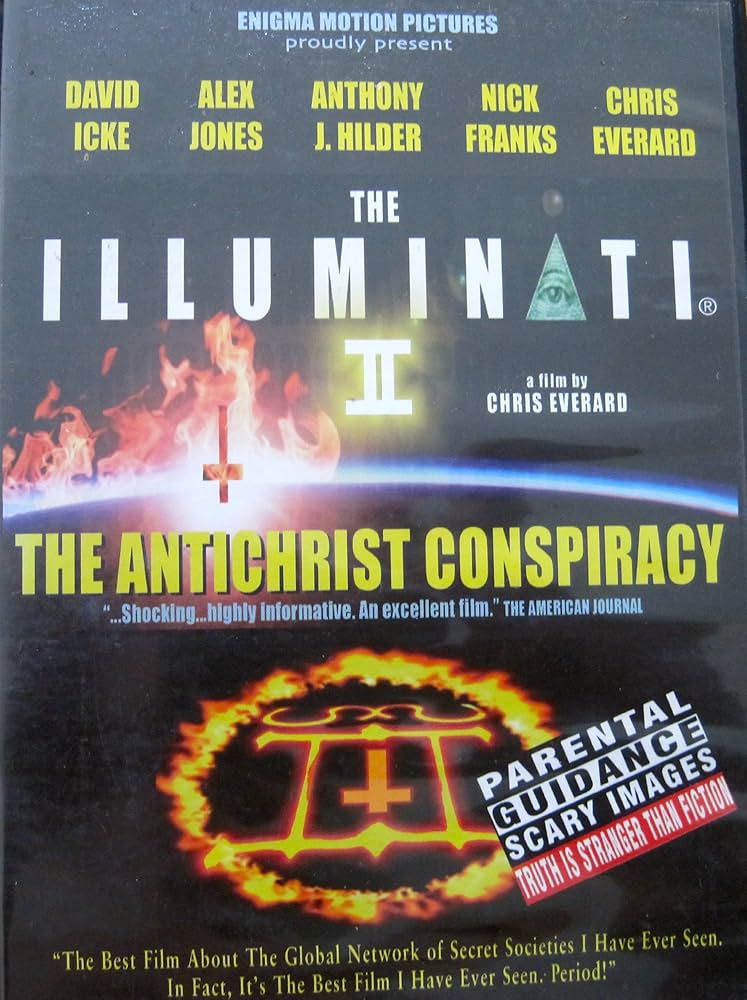
Chris Everard’s The Illuminati II: The Antichrist Conspiracy is the second installment in his self-styled Illuminati documentary series. Billed by its producer Enigma Motion Pictures as part of “a long running conspiracy series”, this 2006 film picks up where The Illuminati (2005) left off. Everard teams up again with fringe figures like Alex Jones and David Icke (both appear as themselves) to weave a sprawling tapestry of global conspiracies. The stated intent is to expose a hidden “network of secret societies” manipulating world events. As a result, its structure is less a coherent narrative than a rapid-fire slideshow of sensational claims.
Global Conspiracy Topics
The film jumps between dozens of wild theories. It asserts, for example, that Bill Clinton was put “under hypnosis” and that the 1992 U.S. presidential election was “fixed”, tying these claims into a larger Illuminati plot. Other bullets in its arsenal include Free Tibet (accused of being co-opted by hidden forces), the lore of Aleister Crowley and the evil eye, and even bizarre ideas like “Jewish vampyrism” and a “Jewish AntiChrist”. It also implicates powerful institutions: the Manhattan Project and Bohemian Grove get sinister conspiratorial spins, CIA mind-control programs (MK-Ultra) feature as alleged Illuminati tools, and the British monarchy’s symbols are reinterpreted as satanic imagery. Occult and pseudo-religious motifs abound (Knights Templar/Holy Grail, the O.T.O., Kabbalah cabals, dual “Antichrists” in Koranic and Judaic tradition, and even a “Golden Demon Child” of Satan). In short, the topics veer from political intrigue to horror-movie fodder.
Presentation and Narrative
Everard narrates in a grave, urgent tone, stitching interviews and archival clips into a sense of dread. The editing is frenetic: bold text overlays and montages of ominous stock footage (burning crosses, pyramids, election crowds) flash onscreen. Transitions often feel abrupt; one minute you’re looking at Communist China’s reaction to a protest, the next at chanting OTO members. The effect is more overload than insight. The structure loosely tries to link each scandalous item back to the Illuminati theme, but often leaps seem tenuous. For instance, an image of Bohemian Grove leads into a segment on the Trinity nuclear test, suggesting (with no evidence) a hidden Illuminati angle to World War II science. The film’s cast of interviewees – conspiracist personalities like Jones, Icke, and author Anthony J. Hilder – do little to explain or justify the connections, serving mainly to nod gravely and assert that “of course” these links prove a grand design.
Production Values
Cinematography is very basic. Almost everything is shot in still images or talking-head interviews. There are no on-location shoots or dramatic reenactments – most footage is recycled news clips, old photographs or symbolic imagery. This gives the film a homemade, slideshow-like feel. The one credit to its visual style is occasional use of eerie stock imagery and ominous music, which does create atmosphere (for better or worse). But overall, the look is low-budget: cheaply lit interview segments, grainy film inserts, and overused doom-laden montages. The direction is straightforward and didactic rather than artistic; Everard avoids obvious goofs but also any subtlety. The editing jumps from topic to topic in service of shock value, resulting in a relentless montage that feels more like a collage of shocking headlines than a reasoned investigation. (In short, imagine a late-night cable special on conspiracy theories – that is the vibe.) These production traits are in line with its Enigma Motion Pictures pedigree: an independent conspiracy-thriller outfit more focused on sensational content than slick craftsmanship.
Scores and Reviews
Critical reception of Illuminati II is virtually nonexistent in mainstream media, and the handful of user ratings it does have are modest. On Moviefone the “Audience Score” sits at 55%. The Brazilian film site Filmow shows an average of only 3.8/10 from 18 votes. A small Spanish-language aggregator (La Vanguardia) lists it at about 60%. An online review portal (in French) even gives it just 5.5/10. On Amazon’s DVD page the sole review happens to be 5/5 stars, but that single praise must be weighed against the very scant overall engagement. IMDb’s user rating hovers around the mid-6/10 range (from only about a dozen votes). In short, any “fan” ratings are mixed-to-low, reflecting its polarizing nature. Rotten Tomatoes and Metacritic have no entries (unsurprising for such an obscure title).
Audience Reaction and Availability
The audience for this film is tiny and niche. Apart from DVD sales and the odd YouTube upload, it isn’t on any major streaming service. The Amazon DVD release (since Jan. 2006) is about the only official way to watch it. You might find clips or bootleg uploads online, but there’s no authorized Netflix/Hulu presence. Among conspiracy enthusiasts on forums, it has a modest cult status – mostly of the “so outrageous it’s fun” variety. More typical viewers (or critics) virtually ignore it. It doesn’t have a social media following worth noting, and it never generated public controversy or discussion beyond the usual conspiracy blogosphere.
Conclusion (Verdict)
The Illuminati II: The Antichrist Conspiracy is unabashedly built for die-hard conspiracy buffs. It throws every fringe theory at the wall – from MK-Ultra footage to “Jewish Antichrists” – in hopes some will stick. Fans of Alex Jones/David Icke-style documentaries might enjoy the ride; it serves up exactly the kind of bombastic, anti-establishment rhetoric that genre devotees crave. However, as a documentary it offers almost nothing to skeptical viewers. The narratives are disjointed, the evidence tenuous, and the whole enterprise feels more like a pulp thriller than a factual exposé. In other words, if you came for credible investigative history, you’ll come away rolling your eyes. For its intended audience it can be an entertaining catalog of conspiracies, but even believers may find the jumps in logic and amateurish style frustrating.
Rating: 4/10
This score reflects its extremely low appeal to general audiences and critics, but acknowledges that it might amuse (or at least intrigue) a very narrow slice of conspiracy-theory fans.
